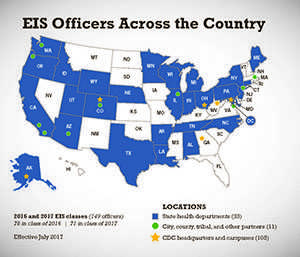Service and Learning
EIS is a unique 2-year post-doctoral training program of service and on-the-job learning for health professionals interested in the practice of applied epidemiology. The following are hallmarks of EIS.

EIS combines experiential and classroom learning.
Service
EIS officers provide service to CDC and other public health partners in multiple ways:
- While at work every day, EIS officers provide on-the-job service.
- In responding to urgent or emergent public health problems, EIS officers support more than 100 field investigations each year in the United States and around the world. See Outbreak Investigations and Emergency Response.
Learning
EIS officers learn through both classroom and on-the-job experience in this competency-based training program. EIS is modeled after a traditional medical residency program where much of the education occurs through hands-on assignments and mentoring.
EIS officers learn to apply the science of epidemiology to solve public health problems. About 95% of learning is experiential. The remainder occurs via classroom instruction, case studies, exercises, and e-learning.
EIS officers report to their work assignments in August, immediately after the summer course. In late fall, EIS officers attend a 1-week course on public health surveillance methods and advanced epidemiologic techniques.
Second-year EIS officers complete additional advanced epidemiologic courses via e-learning.
All EIS officers attend weekly epidemiology seminars and the annual EIS Conference where they present findings from their investigations and studies. Through these events, they develop their presentation skills. They also meet and learn from fellow officers, CDC epidemiologists, and other leaders in public health and epidemiology, many of whom are EIS alumni.
First-year EIS officers begin each July with an intensive, 1-month orientation in Atlanta, Georgia. The summer course covers biostatistics, public health ethics and law, communication and media training, and other broad public health topics.
EIS officers report to their work assignments in August, immediately after the summer course. In late fall, EIS officers attend a 1-week course on public health surveillance methods and advanced epidemiologic techniques.
Second-year EIS officers complete additional advanced epidemiologic courses via e-learning.
Core Activities of Learning
The EIS program’s competency-based education incorporates prescribed Core Activities of Learning (CALs). All EIS officers must complete the CALs, which enable them to develop proficiency as skilled epidemiologists who can effectively address public health challenges. The CALs are to:
- Conduct or participate in a field investigation of a potentially serious public health problem that requires a timely response
- Design, conduct, and interpret an epidemiologic analysis
- Evaluate a public health surveillance system
- Give a public health talk on original work or field of study
- Give an oral presentation to a scientific audience
- Write and submit a scientific manuscript for a peer-reviewed journal as first author
- Write and submit a concise public health update that communicates timely information as the primary author
- Write and submit an abstract as first author
- Communicate complex scientific concepts to a nonscientific audience
- Provide service to the agency
- Page last reviewed: June 7, 2016
- Page last updated: July 18, 2017
- Content source:



 ShareCompartir
ShareCompartir
